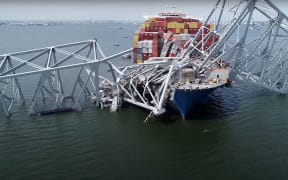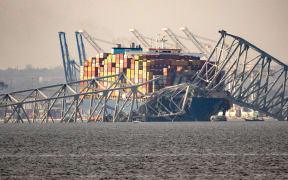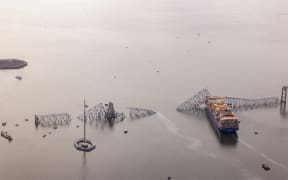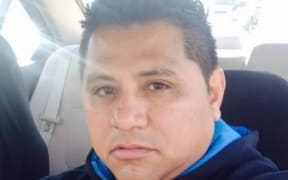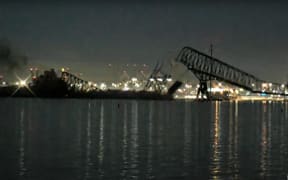By Audrey Courty for the ABC

The container ship Dali crashed into Baltimore's Francis Scott Key Bridge on Tuesday night, New Zealand time, sending it crumbling into the harbour. Photo: Getty Images via AFP
The pilot of the cargo ship that knocked down a highway bridge into Baltimore Harbour had radioed for tugboat help and reported a power loss minutes earlier, federal safety officials say, citing new data from the freight's recorder.
The head of the United States National Transportation Safety Board (NTSB), Jennifer Homendy, also said the Francis Scott Key Bridge lacked structural engineering redundancies common to newer spans, making it more vulnerable to a catastrophic collapse.
New insights into the fatal disaster emerged a day after the massive Singapore-flagged container ship Dali sailed out of Baltimore Harbour, before reporting loss of power and then crashing into a support pylon of the bridge.
The impact brought most of the bridge tumbling into the mouth of the Patapsco River within seconds, blocking shipping lanes and forcing the indefinite closure of the Port of Baltimore, one of the busiest on the US Eastern Seaboard.
Divers on Thursday recovered the remains of two of the six workers missing since the crumbling bridge tossed them into the water, officials said.
The NTSB chief held a news conference shortly afterwards, saying the board had begun collecting evidence from the ship and the probe could take up to two years.
"We will not provide any sort of findings, conclusions, or any safety recommendations while on scene," Homendy said.
"Our entire focus on scene is to collect the perishable evidence. That's documenting the scene, taking photographs, taking any sort of electronics or components, and whatever goes away once the scene is cleaned up."
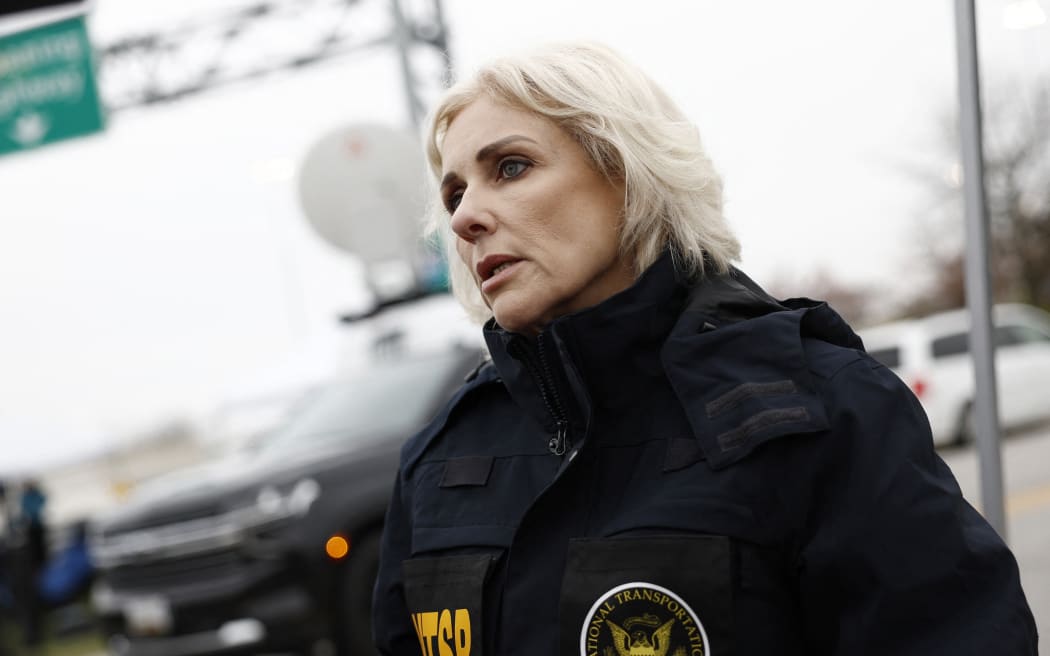
United States National Transportation Safety Board chief Jennifer Homendy. Photo: AFP/Anna Moneymaker
Key Bridge did not have any redundancy
While a preliminary report will not be released for at least another two weeks, Homendy said the Key Bridge, which was built in the 1970s, was "fracture critical".
"What that means is if a member fails, that would likely cause a portion of - or the entire - bridge to collapse. There's no redundancy," she said.
"The preferred method for building bridges today is that there is redundancy built in, whether that's transmitting loads to another member or some sort of structural redundancy."
There are 17,468 other fracture-critical bridges across the US, out of 615,000 bridges in total, Homendy said, citing the Federal Highway Administration.
She said the Key Bridge had been in "satisfactory condition", with the last fracture-critical inspection conducted in May 2023.
"We have not been able to go through that inspection but that will occur when we leave the on-scene portion," she said.
"We have also requested all fracture-critical routine and underwater inspections over the last decade."
Ship's pilot called for tugboat help
NTSB's investigator in charge, Marcel Muise, said the recovered voyage data recorder (VDR) had helped them establish a timeline of events.
He said the ship had departed from Seagirt Marine Terminal at around 12.39am and had entered the Fort McHenry Channel at 1.07am, before "numerous audible alarms" were recorded on the audio from the ship's bridge at 1.24am.
At about the same time, the data stopped recording, though it resumed shortly after tapping into a redundant power source, Muise said.
At 1.26am, the ship's pilot made a high frequency radio call for tugboats to assist the Dali in what Homendy said was the first sign of needing help.
The pilot later dropped the port anchor and made another radio call at 1.27am, reporting the ship had lost all power and was approaching the bridge.
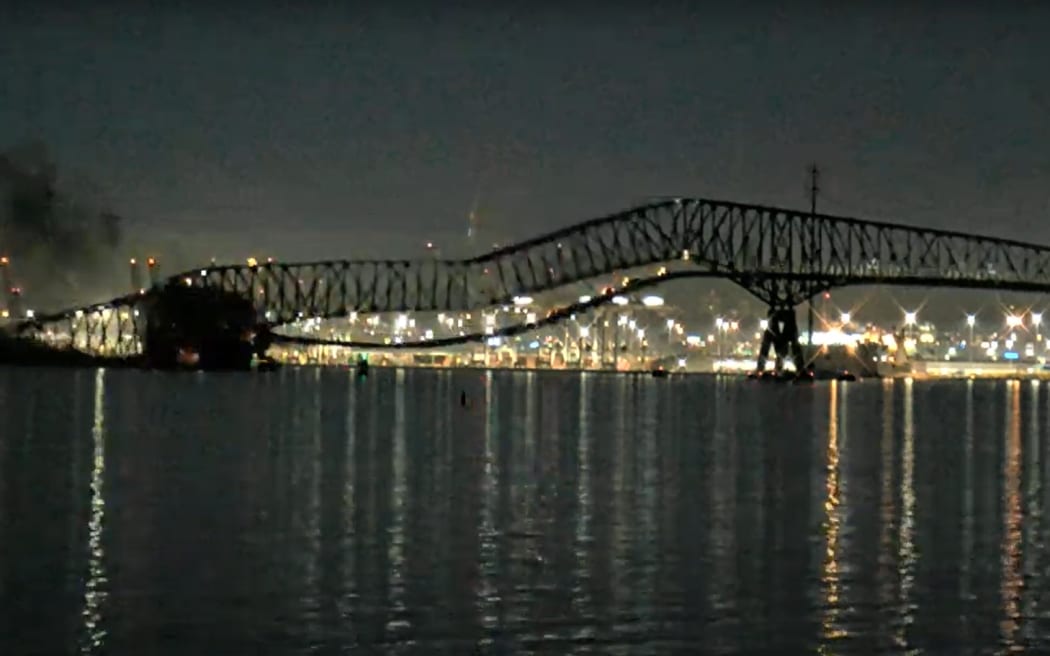
The Francis Scott Key Bridge buckles and crashes into the water. Photo: Screenshot / Stream Time Live
The ship's speed over ground was recorded at around 12.9kph before it collided with the bridge's support pylon at 1.29am.
Homendy said although the data recorder was a "newer model", it was more limited than what would be recorded in an airplane's black box.
"It is very basic compared to, say, a flight data recorder where we would have a thousand parameters," she said.
Muise said the voyager data included GPS coordinates, audio, rudder feedback, rudder commands, as well as snapshots of the radar and electronic chart.
But the device did not record information about engineering, like the temperature of each cylinder, and power distribution censors, he said.
Data 'consistent with a power outage'
Homendy said it was too early in the investigation to say whether having this extra data could have helped explain what caused the ship's power outage.
"We have data which is consistent with a power outage, however, we don't have factual information that can confirm that power outage, so we aren't there yet."
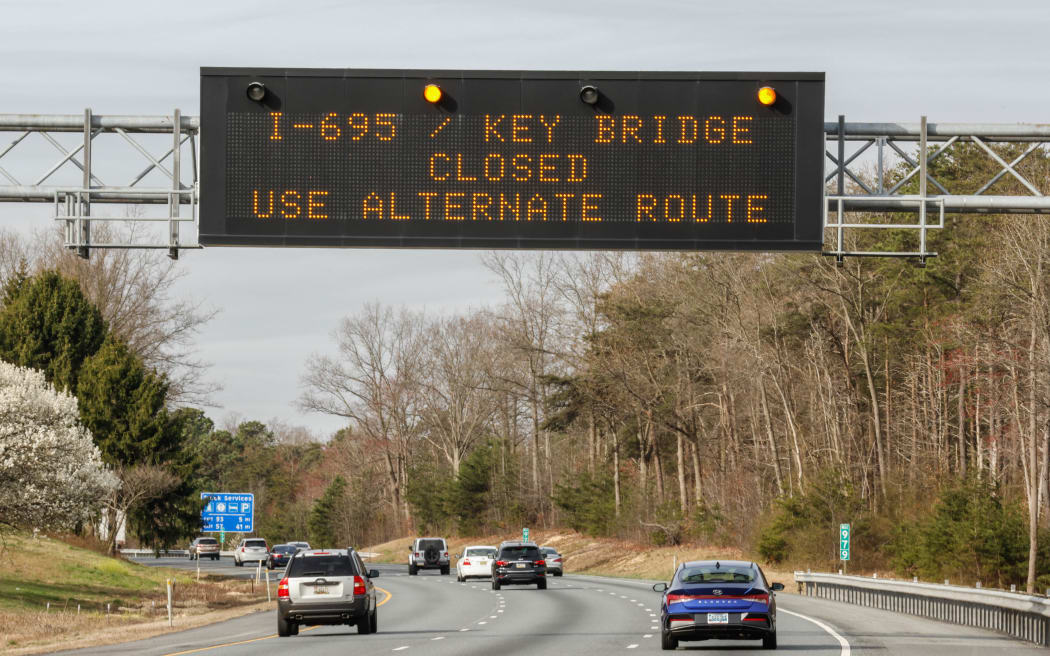
The 3km bridge was part of Interstate Highway 695. Photo: Getty Images via AFP
She said there could be up to 30 days worth of historical data on the VDR for NTSB to examine once they leave the scene of the crash.
Muise said they would need to consult other parties to filter out the noise of the alarms and other background noise in the audio before they could make sense of it.
Homendy said the board had already spoken to the ship's captain and engineers, and planned to interview the two pilots on Friday.
"It's pretty devastating, certainly, seeing not just what's going on with the cargo containers, but just looking at what was a bridge span ... it's just utter devastation."
"When I look at something like that, I'm not thinking about the container ships, I'm not thinking about traffic getting back up on the bridge, I'm thinking about the families who have lost loved ones ... and what they must be going through."
Homendy said the board had already spoken to the ship's captain and engineers, and planned to interview the two pilots on Friday.
She also said they had collected a sample of the ship's fuel to examine whether contaminated fuel was partly to blame for the power outage.
"We have an amazing team of individuals who are focused on very specific areas of expertise and so I have no doubt that we will be able to pull this together in, hopefully, 12 to 24 months."
This story was originally published by the ABC.
